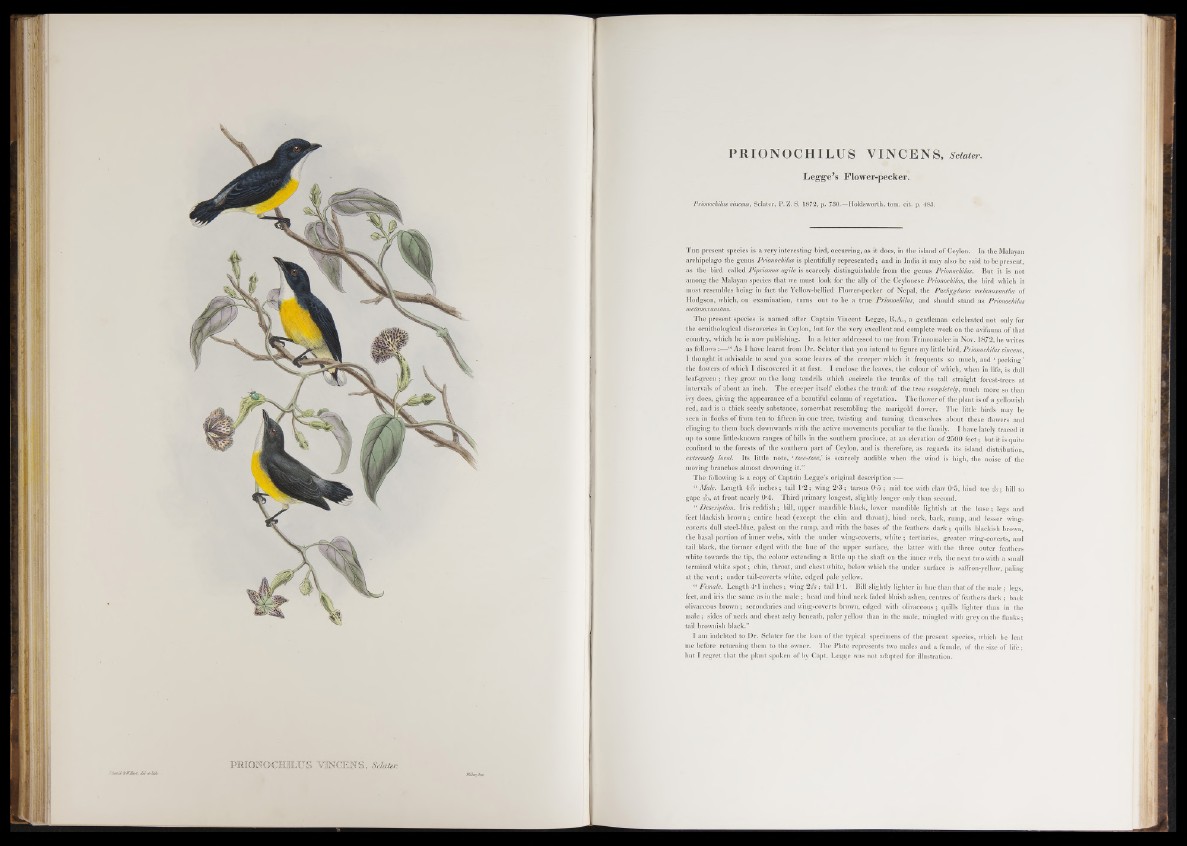
PE.IOWOCHILUS 'VJNCENS, Sdater.
P R I O N O C H I L U S Y I N C E N S , S c l a t e r .
Ltegge’s Flower-pecker.
Prionochilus vincens, Sclater, P. Z. S. 1872, p. 730.—Holdsworth, tom. cit. p. 483.
T h e present species is a very interesting bird, occurring, as it does, in the island o f Ceylon. In the Malayan
archipelago the genus Prionochilus is plentifully represented; and in India it may also be said to be present,
as the bird called Piprisoma agile is scarcely distinguishable from the genus Prionochilus. Bjit: it is not
among the Malayan species that we must look for the ally of the Ceylonese Prionochilus, the bird which it
most resembles being in fact the Yellow-bellied Flower-pecker of Nepal, the Pachyglossa melanoxantha of
Hodgson, which, on examination, turns out to be a true Prionochilus, and should stand as Prionochilus
melanoxanthus.
The present species is named after Captain Vincent Legge, R.A., a gentleman celebrated not only for
the ornithological discoveries in Ceylon, but for the very excellent and complete work on the avifauna of that
country, which he is now publishing. In a letter addressed to me from Trincomalee in Nov. 1872, he writes
as follows:— “ As I have learnt from Dr. Sclater that you intend to figure my little bird, Prionochilus vincens,
I thought it advisable to send you some leaves of the creeper which it frequents so much, and ‘ pecking ’
the flowers of which I discovered it at first. I enclose the leaves, the colour o f which, when in life, is dull
leaf-green ; they grow on the long tendrils which encircle the trunks of the tall straight forest-trees at
intervals of about an inch. The creeper itself clothes the trunk of the tree completely, much more so than
ivy does, giving the appearance o f a beautiful column of vegetation. The flower of the plant is o f a yellowish
red, and is a thick seedy substance, somewhat resembling the marigold flower. The little birds may be
seen in flocks of from ten to fifteen in one tree, twisting and turning themselves about these flowers and
clinging to them back downwards with the active movements peculiar to the family. I have lately traced it
up to some little-known ranges of hills in the southern province, at an elevation o f 2500 fe e t; but it is quite
confined to the forests o f the southern part o f Ceylon, and is therefore, as regards its island distribution
extremely local. Its little note, ‘ tsee-tsee,’ is scarcely audible when the wind is high, the noise o f the
moving branches almost drowning it.”
The following is a copy o f Captain Legge’s original description :—
“ Male. Length 4i& inches; tail 1*2; wing 2-3 ; tarsus 0-5 ; mid toe with claw 0’5, hind toe ; bill to
gape -is, at front nearly 0 -4. Third primary longest, slightly longer only than second.
“ Description. Iris reddish; bill, upper mandible black, lower mandible lightish a t the b a se ; legs and
feet blackish brown ; entire head (except the chin and throat), hind neck, back, rump, and lesser wing-
coverts dull steel-blue, palest on the rump, and with the bases of the feathers dark ; quills blackish brown,
tbe basal portion of inner webs, with the under wing-coverts, white ; tertiaries, greater wing-coverts, and
tail black, the former edged with the hue of the upper surface, the latter with the three outer feathers
white towards the tip, the colour extending a little up the shaft on the inner web, the next two with a small
terminal white sp o t; chin, throat, and chest white, below which the under surface is saffron-yellow, paling
at the vent; under tail-coverts white, edged pale yellow.
“ Female. Length 4*1 inches; wing 2#o; tail 1-1. Bill slightly lighter in hue than that o f the m ale; legs,
feet, and iris the same as in the male ; head and hind neck faded bluish ashen, centres of feathers dark ; back
olivaceous brown; secondaries and wing-coverts brown, edged with olivaceous; quills lighter than in the
male; sides of neck and chest ashy beneath, paler yellow than in the male, mingled with grey on the flanks;
tail brownish black.”
I am iudebted to Dr. Sclater for the loan of the typical specimens of the present species, which he lent
me before returning them to the owner. The Plate represents two males and a female, of the size of life;
but I regret that the plant spoken of by Capt. Legge was not adapted for illustration.